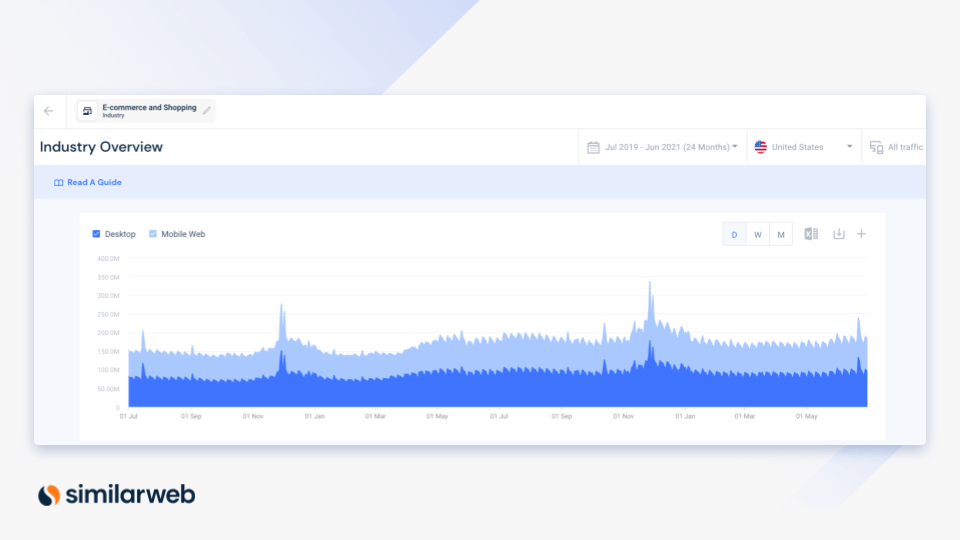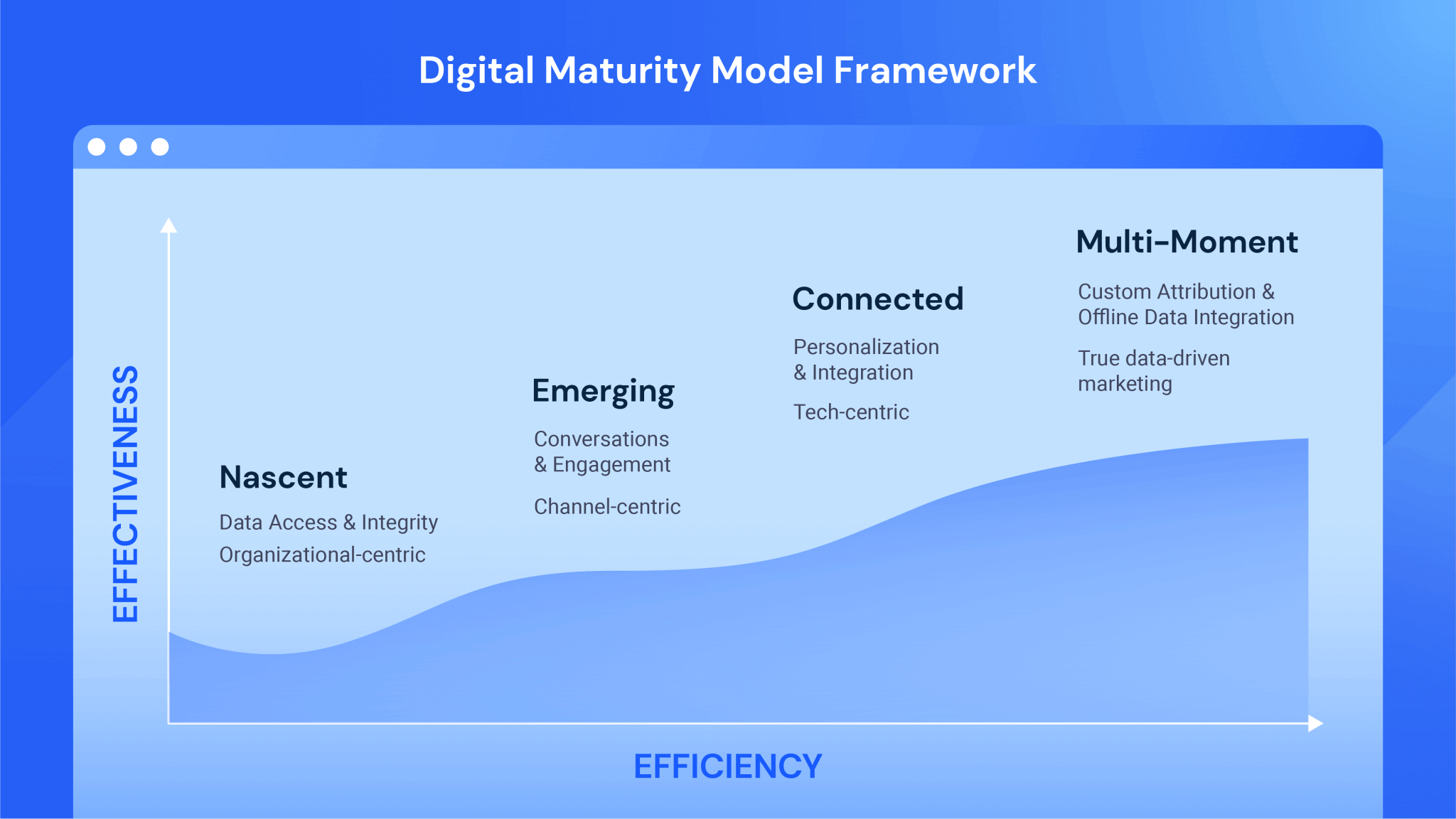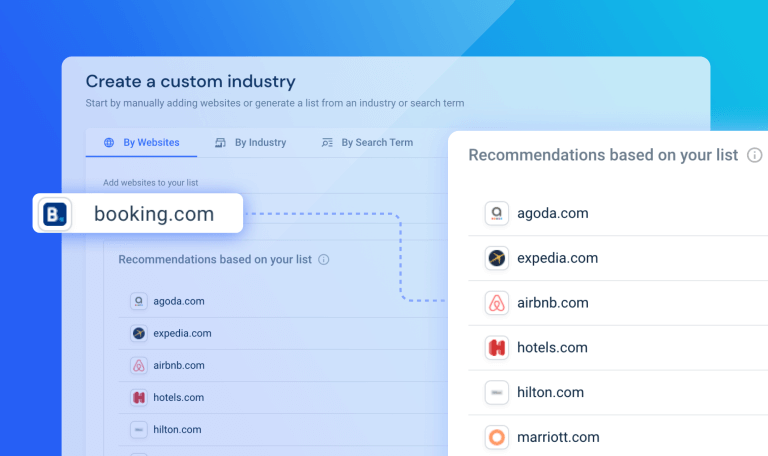Keeping Up Isn’t Enough. How to Lead the Digital Transformation Game

Change is scary and not something that we always willingly embrace. When it comes to the unknown, one nagging question weighs: What if the grass isn’t really greener on the other side?
And while many of us learn to adapt without a clear understanding of what lays ahead, in the digital world, change isn’t really that unpredictable after all.
Whether you’re a digital marketer, a researcher, or a business analyst, we’re all somewhere on the journey that is digital transformation.
And while no one can predict with 100% certainty where we’re going, you can use data-driven research intelligence to help you stay agile and predict where you’ll end up. Spoiler: Don’t just go along for the ride, start navigating.

What is digital transformation? The latest revolution
Some people compare digital transformation to the industrial revolution since it’s impact is so massive.
Let’s look at the digital transformation definition: Digital transformation is the process of restructuring of an organization’s processes with digital technology and its impact on work processes, internal hierarchies, and business models.
But, we are talking about more than just adopting new technology, like Zoom meetings. The meaning behind digital transformation represents a fundamental shift in your business strategy.
What’s driving this change? Customer (and employee) expectations.
Digital technologies aren’t new. But the rapid transformation is. The standards are changing rapidly.
This doesn’t just apply to customers, looking for immediate results and a seamless user experience. Employees are also looking for automation and efficient solutions to improve their workflow. For example, the expectation is for data analysis to be fast, accurate, and intuitive.

It’s important to note here that digital transformation is not the same as digital maturity, although the two are closely related.
While digital transformation is the actual process of changing your workflow in accordance with digital technologies, your maturity level is a measure of your ability to actually undertake these changes.
For example, let’s say most of your internal business processes are conducted manually – you would have a low digital maturity, and thus transformation will take you long until you automate these processes.
Everyday examples of digital transformation
We’re living in the digital age. And when you think of an industry that has been the most obviously affected by new technology, what’s the first thing that comes to mind? You probably think of the eCommerce ecosystem as the most striking example of modernization. Indeed, retailers who traditionally sell goods in physical stores have added online shopping experiences as part of the book of business to keep up with growing demand- last month alone 17 billion people visited online retail websites.

But there are other, more successful digital transformation examples to learn from.
Take a look at how the financial world evolved and, with it, our understanding of money.
Hard cash – once the only currency – is still around, but what do you use it for? When was the last time you paid with a check? We’ve moved on to credit cards, payment platforms, and now payment apps or e-wallets. Most money is online. Consider this: in Norway only 3-4% of transactions are completed with cash. It doesn’t seem as dramatic as the shift from retail to eCommerce, a transformation that received a powerful boost during the pandemic-stricken year 2020. However, digital transformation in finance is a lot more significant. Not only did it force companies to adopt new technologies in order to meet customer needs, but it completely altered our perception of money.
Now let’s take a step back even further. Think of any everyday activity now a part of your daily routine. We can control our homes from afar with smart home apps, and in smart cities, digital technologies control traffic lights, electricity, water supply, and so on.
Digitalization has even moved into traditional manufacturing, where the internet of things (IoT) enables digital monitoring and operation of entire production floors and supply chains.
Leading the digital disruption charge
Any company that is more digitally advanced will raise the industry standard as well as user expectations.
When a leading company has stepped up digitization, it’s just a matter of time until consumers demand the same from everybody else. Maybe it’s new products or an even better customer experience. Think chatbots. Most people expect their questions to be answered immediately without calling or waiting for a response. Regardless of what the new expectation is, you could go with the flow and react to changing demand. But would you try riding a bike for the first time with your eyes closed?
With a well-thought digital transformation strategy, you take a proactive approach and place yourself among the companies that set the pace for the rest of your market.
Digital transformation makes for more productivity and efficiency as well as increased visibility and scalability in every area of life. Having a strategy will help you avoid error-prone manual processes and increase operational efficiency.
A look at the popular digital maturity model developed by Google and Boston Consulting Group (BCG) explains that companies that reached the highest level of maturity are in a state of continuous improvement and constant change. You’re ready for unexpected challenges because you’ve been experimenting with trial and error.
You already know how you can use technology to your advantage because you’re familiar with it. This means you can find better services or faster products and react to disruptions in real-time.
Part of being digitally mature is realizing that you need to keep changing, developing, improving, and transforming. The sooner you realize where you are on the digital transformation journey, the more effectively you can control and plan your progress. In a few year’s time, it won’t be something that you should do to be competitive, it will be what you have to do to stay alive in the digital world.
Want to know where you are on your path towards digital transformation? Check out the digital maturity model below:

5 simple steps to radical digital transformation
Effective digital transformation can seem like an arduous task, but it doesn’t have to be. Break it down into these 5 simple steps and you’ll be well on your way to achieve digiality maturity in now time.
Step 1: Measure your digital maturity level
In order to implement digital transformation, you need to know where you stand. Your first step is to perform company research and collect relevant data on your market. You may want to use a digital maturity index to analyze where your company stands on its journey. Have you purposefully integrated new technologies into your organization? Define which digital tactics you currently have in place, and ask yourself if those technologies are giving you a strategic advantage over the competition. Gathering insights on your audience will also help this process.
Step 2: Envision where you want to be
This is where some self-help principals come in handy. At this stage, don’t limit yourself to what you know is possible or exists, but create a vision of what you would want for your company.
Pinpoint the strategic gaps you want to fill and how technology can help support your employees. What experience do you want to provide for your customers? This is also the time to get the buy-in from the management and key stakeholders. You’ll need them aboard because the changes are going to affect every area of the business. Build a roadmap to better visualize what you are trying to achieve.
Step 3: Investigate your options
Check what digital platforms the market offers and investigate available technologies and solutions.
Using data analytics, you can validate your options and set specific KPIs. Then prioritize, set business goals and build a digital transformation strategy. There will be a lot of options out there, so make sure that you evaluate your decision-making based on the processes you want to optimize.
Step 4: Try, train, reorganize
It’s decision time. This is the time to determine what you build, which tools to buy, and what to outsource. Remember, every employee faced with new technology needs training, which needs to be part of the plan. Digital transformation will require the reorganization of workflows, responsibilities, and hierarchy.
Step 5: Level up and optimize
No process is complete without optimization. Here’s how: Repeat steps 1–4 in reasonable intervals, improving your processes each time. Remember that continuous improvement is the key to growing digitally mature.

Speed up your digital transformation journey
Don’t forget that we are all traveling on this path of digital transformation. So where you find yourself on the journey is less relevant, as long as you are continuously working towards improvement. After all, the pace at which industries and regions advance varies.
What’s important is how you approach digital transformation. Will you lay back and let the changes pull you along? Or are you going to become proactive and drive the necessary changes?
Similarweb’s research intelligence provides the most reliable real-time web analytics to support a proactive approach. By combining internal company data with industry benchmarks and competitors’ performance, you’ll have the information that lets you monitor relevant metrics, create action plans, set achievable strategic goals and eventually accelerate digital business transformation. Get the insights you need to accelerate your digital transformation.
This blog post was written by Ruth M. Trucks.
FAQ
What are the 4 main areas of digital transformation?
The 4 main areas of digital transformation are process transformation, business model transformation, domain transformation, and cultural/organizational transformation.
What is an example of digital transformation?
An everyday example is that we can control our homes from afar with smart home apps.
Get ahead of game-changing consumer trends
Contact us to set up a call with a market research specialist









